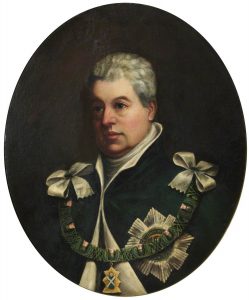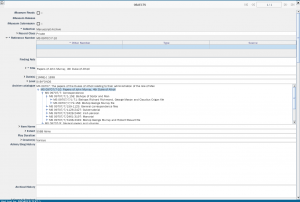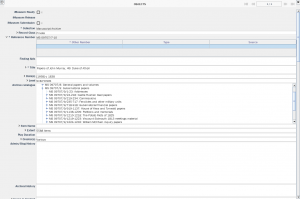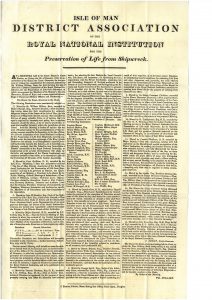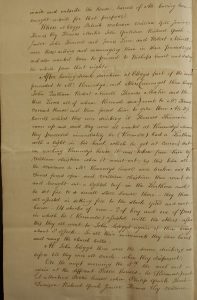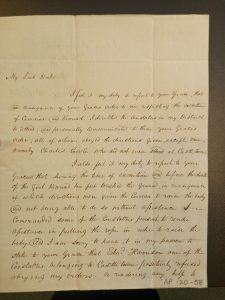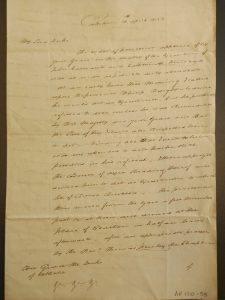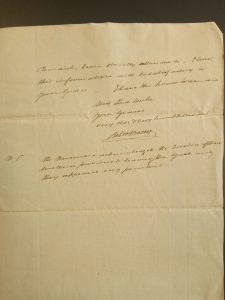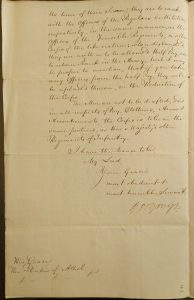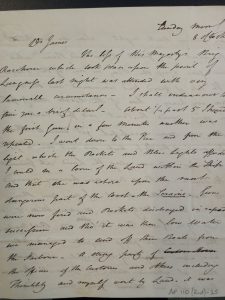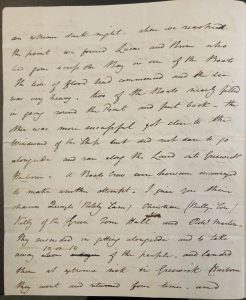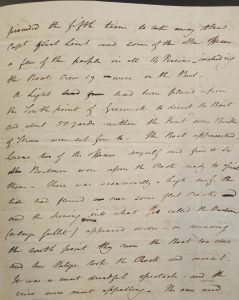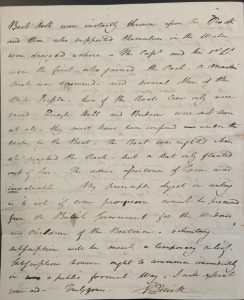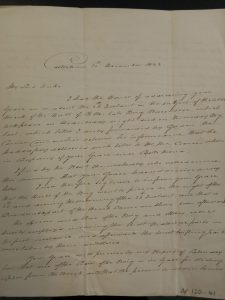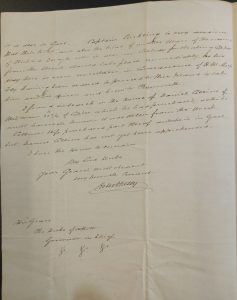The Atholl Papers: Project Finale
You may be wondering what happened to all those blogs that I promised on the papers of the 4th Duke of Atholl, in my last post, all the way back in May 2022 (a promise I’ve now sneakily erased)? Unfortunately, as much as I wanted to explore the 4th Duke’s era with you, the size of his papers and the remaining time available dictated otherwise. While the papers of the 2nd and 3rd Dukes total around 1800 item-level records, combined, the number of items in the 4th Duke’s papers stretch beyond 5500, with his correspondence files accounting for 3349 of those items. As such, something had to give in order to ensure that a useable catalogue of the 4th Duke’s records surfaced before the project came to a close, and sadly, this blog was sacrificed to allow that to happen. Therefore, in this final post for the Atholl Papers Project, I will give you a short summary of my work with the 4th Duke’s material, and a cursory overview of some of the topics found within his papers.
John Murray, 4th Duke of Atholl (1755-1830) (image courtesy of the Museum of Freemasonry)
Unlike the papers of the 2nd and 3rd Dukes, which were fairly simple in comparison, the 4th Duke’s material is a complex mix of files and volumes relating to the Atholls’ manorial rights on the Isle of Man and the Duke’s tenure as governor, the latter between 1793 and 1830. This is further complicated by a host of files that have no clear separation between the Duke’s manorial and gubernatorial relationships on the island, which is not entirely surprising, given that the two inevitably became intertwined as the years progressed, partly as a consequence of the Duke’s general attitude that he was essentially ‘Lord of Mann’ in all but name. However, as a result, this caused a headache when determining the top-level arrangement for his papers. Given the predominance of correspondence files in the Duke’s papers, and the remaining files containing supplementary material like reports, abstracts of accounts and other documents, many of which originally accompanied the letters, I decided to split his records into four main sections: correspondence, general papers (files containing gubernatorial and manorial material or items relating to neither category), gubernatorial papers, and manorial papers. Whether this was the best course of action or not, I will leave that up to you to decide. However, I felt the decision taken was the best way of simplifying the arrangement to aid readers’ use of the papers. The images below demonstrate how some of those sections were sub-divided further.
Manx National Heritage collections database [Click images to enlarge & read.]
If you read my project update post in February 2022, you will know that I practically re-wrote all the item-level descriptions for the 2nd and 3rd Dukes’ papers, disregarding the vast majority of the hard work previously undertaken by Manx National Heritage’s volunteers (sorry volunteers), who inputted the descriptions originally produced by Neil Mathieson in the 1950s on to Excel spreadsheets, and then subsequently improved upon what he had done. However, when it comes to the 4th Duke’s papers, much more of the volunteers’ efforts survive. Quite frankly, without their work, I would not have been able to catalogue his correspondence files down to item-level; from scratch, such depth would have likely taken me two years to complete, not taking into account the other files and volumes present. There were still the same issues, as found in the other Dukes’ papers, concerning inaccurate dating, incomplete descriptions, and the occasional wrong attribution of author or recipient. These were corrected, with an emphasis on fleshing out the descriptions as much as time would allow.
Time constraints have always been the impetus and burden of this project. I knew, as I began work on the 4th Duke’s records, that I would not be able to catalogue all of them down to item-level in the year or so that remained. On completion of the 2nd and 3rd Dukes papers, I came to the conclusion that I would focus my efforts on the 4th Duke’s correspondence files. Like his predecessors, the 4th Duke’s correspondence is where all the meat resides; the fascinating narratives and juicy nuggets of information, which have made the Atholl Papers a joy to catalogue, and are supplemented by the records in the other files. As for these non-correspondence files, the decision was taken to catalogue them down initially only to file or sub-file level, and if time allowed, go down to item-level. Thankfully, I found (as I had forgotten) that I had previously written new descriptions for the items in some of these files, undertaken as part of the preliminary arrangement work at the beginning of the project, which had been done to aid my understanding of what were in these files and their relationships with the other material present. Therefore, more of these non-correspondence files are catalogued to item-level than I originally intended or expected.
Before I move away from the brief summary of my work on the 4th Duke’s papers, I should also note that there is a very small amount of records in the Atholl Papers that go beyond his era, relating to the 5th and 6th Dukes. These items largely concern the disposal of funds after the 4th Duke sold the family’s remaining Manx manorial rights and ecclesiastical patronage over the Bishopric of Sodor and Man in 1828, and the establishment of a trust to oversee the 5th Duke’s interests, following the 4th Duke’s death in 1830. The 5th Duke had been declared a ‘lunatic’ in 1798.
Proceedings of the first meeting of the Isle of Man District Association of the Royal National Institution for the Preservation of Life from Shipwreck (MS 09707/7/1977) [Click image to enlarge & read.]
A major theme in the 4th Duke’s papers revolves around his attempts to ascertain and establish what manorial rights the Atholls retained on the Isle of Man. These rights had been left in a mutilated state by the 1765 Act of Revestment, and what privileges the family believed themselves to still hold were openly abused by Manx Crown officials. On its own, it is a fairly dry topic. However, this matter also forms part of the wider and far more interesting factional conflict that rages throughout the Duke’s era, involving himself and the House of Keys. It essentially began in 1779, when the Duke’s seneschals/stewards, John Quayle the Younger (father of George Quayle) and William Callow, were dismissed from His Grace’s employ after being found to have exploited their positions to enrich themselves and their families at the Duke’s expense, mainly through their leasing of manorial properties and rights at significantly reduced rates. A vengeful Quayle, along with the Keys, then proceeded to oppose the Duke’s Bills and petitions to Parliament in the 1780s and early 1790s, which centred on identifying the family’s manorial rights and investigating abuses connected to insular governance. During this period, Quayle and his allies also caused mischief between Lord Atholl and the Dowager Duchess, involving themselves in a disagreement between mother and son over who was the rightful owner to the patronage of the Bishopric of Sodor and Man.
In 1801, the Duke submitted a Bill to Parliament to receive compensation for the Revestment, which eventually led to him receiving an annual rentcharge on the Isle of Man’s surplus revenue in 1805. This new attempt by Lord Atholl reignited the conflict between himself and the House of Keys. However, on this occasion and in future skirmishes between the two factions, His Grace now had the support of various merchants and ‘gentlemen,’ who sought the disbandment of the Keys in favour of a new democratically-elected body, which the Keys were certainly not in this period; the term ‘incestuous’ comes to mind.
The dispute between the two sides rolled back and forth, hot and cold, for the next two decades, with new players choosing sides during the interim, including: Bishop George Murray, who joined the ranks of his uncle’s supporters, and Lieutenant Governor Cornelius Smelt, who sidled up to the House of Keys. Lord Atholl’s relationship with the Keys would go on to deteriorate beyond the point of repair in the early 1820s, and the conflict between the opposing factions culminated in what are known as the Potato Riots of 1825. By 1825, it appears that the Duke had had enough of the Keys and the Isle of Man, and it was announced that he would sell the family’s remaining rights and ecclesiastical patronage to the British Crown, which was finalised in 1828. 1825 was also the year that Bishop Murray decided to enforce his claim to the green crop tithe, which previous bishops had not attempted to collect for quite some time. If you believe the Bishop, members of the Gawne family and other individuals of the Keys roused landowners and tenants into a frenzy over this matter, which led to tithe collectors being assaulted, tithe stacks being burnt and other acts of arson, and the Bishop and his family having to flee from Bishopscourt and seek refuge at the Duke’s residence, Castle Mona, under armed guard. If it was the Keys’ intention to rid themselves of any vestiges of the Murray family, following the Duke’s decision to vacate the island, they succeeded. Bishop Murray went on to accept the Bishopric of Rochester in 1827, only remaining on the isle for as long as he did for the sake of his uncle, helping the Duke with the sale of the family’s rights and ecclesiastical patronage to the British; a matter documented in the manorial correspondence files and other papers.
Statement from John Kermode as to the riots in the Isle of Man. c. January 1826 (MS 09707/9/1214) [Click images to enlarge & read.]
Beyond the factional squabbling narrated in the 4th Duke’s records, the gubernatorial aspects of his papers are probably the most interesting. There is a whole host of reports concerning the inmates held in Castle Rushen’s gaol, most of whom were debtors, though the occasional rioter was thrown in there during the early 1820s, due to a few civil disturbances that arose in 1821 and 1823. You also find papers relating to the murderous lovers, John Camaish and Catherine Kinrade, who were executed in April 1823 after poisoning Camaish’s wife (who was also Kinrade’s sister). It is interesting to note that Kinrade gave birth to a child while awaiting trial and execution, which is a detail I did not find in various secondary sources on this matter.
Letter from Thomas Arthur Corlett, Castletown to John Murray, 4th Duke of Atholl, 18 April 1823 (MS 09707/7/2028) [Click images to enlarge & read.]
Letter from Robert Kelly, Castletown to John Murray, 4th Duke of Atholl, 18 April 1823 (MS 09707/7/2029) [Click images to enlarge & read.]
For the more military-inclined amongst you, there are 17 files of papers relating to the Royal Manx Fencibles and other companies raised on the Isle of Man, mainly during the 1790s and early 1800s, along with covering other aspects of insular defence. Lieutenant Governor Shaw’s correspondence files are also dominated by matters concerning the raising and outfitting of the 1st and 2nd battalions of the RMF.
Letter from Sir George Yonge to John Murray, 4th Duke of Atholl, 20 February 1793 (MS 09707/9/238) [Click images to enlarge & read.]
Weekly return for Royal Manx Fencibles, 20 May 1793 (MS 09707/9/257) [Click image to enlarge & read.]
On a final note of what topics can be found within the 4th Duke’s papers, I will close with the shipwreck of H.M.S. Racehorse in 1822. Just like the 2nd Duke’s period, the 4th Duke’s era has its fair share of wrecks off the Manx coast. However, unlike those other wrecks, that of the Racehorse was the catalyst for the establishment of what would become the Royal National Lifeboat Institution. Another blog post on the Racehorse, here on the iMuseum website, covers the incident, so I won’t repeat what happened. The 4th Duke’s papers, along with providing an account of the incident, gives details on the aftermath: the raising of a subscription by locals for the families of the three Manxmen lost during the rescue of the Racehorse’s crew and passengers, and the eventual decision by the British Admiralty to award these families a pension as compensation for the loss of their loved ones; the detention of the pilot accused of being responsible for the wreck; the theft and sale of stolen copper from the wreckage, and the imprisonment of those involved; and the auction sale of the wreckage.
Letter from George Quirk to James Quirk, 15 December 1822 (MS 09707/7/902) [Click images to enlarge & read.]
Letter from Robert Kelly to John Murray, 4th Duke of Atholl, 30 December 1822 (MS 09707/7/2012) [Click images to enlarge & read.]
I remember questioning myself, two years ago, on whether moving to another country (for those ‘across,’ the Isle of Man is not part of the United Kingdom) in the middle of a pandemic was a bright idea. The imposition of a lockdown on the isle, prior to my arrival, did nothing to quell those misgivings that I had. However, as my time at Manx National Heritage and on the island comes to an end, I can happily say that I have no regrets on relocating, and I have come to regard both as my home. The Atholl Papers Project has been a fantastic opportunity for me. The papers are fascinating, opening a window into a period of Manx history that is perhaps not as well known or explored as it should be, and this archive is but one of a number from this era that merit closer inspection, all held at the Manx Museum. On a personal level, the project has allowed me to obtain experience and skills that I previously lacked, especially in regards to delivering outreach activities, all of which will serve me well in the future.
By the time this final blog is published, I will have finished at MNH and be preparing to leave the Isle of Man to start my next appointment, back in England. The catalogue records for the 4th Duke’s papers will have also been released, via the iMuseum website. I would like to thank MNH for my time here, and also express my gratitude to the volunteers for all the hard work they put in prior to my arrival (the warm corner in the reading room is also now free for one of you to claim!).
I don’t do goodbyes, so I will just leave you with this: if you are unfortunate enough, you will all see me again!
Read The Atholl Papers Blog:
The Atholl Papers: The Post-Revestment Turmoil
The Atholl Papers: The Revestment
The Atholl Papers: Project Update
The Atholl Papers: Captain Dow and the Dutch Dogger
The Atholl Papers: The Jacobite Rising of 1745
The Atholl Papers: The Case of Carolina Elinora Mahon
The 2nd Duke of Atholl’s Inheritance of the Isle of Man
The Atholl Papers: An Introduction to the Project
Gareth Pugh
Manx National Heritage Project Archivist (The Atholl Papers)
Blog Archive
- Edward VII’s Coronation Day in the Isle of Man (9 August 1902)
- Victoria’s Coronation Day in the Isle of Man (28 June 1838)
- Second World War Internment Museum Collections
- First World War Internment Museum Collections
- Rushen Camp: Second World War Internment on the Isle of Man
- Hutchinson, Onchan & Peveril Camps: Second World War Internment on the Isle of Man
- Douglas Promenade: Second World War Internment on the Isle of Man
- Mooragh Camp: Second World War Internment on the Isle of Man
- Sculpture collection newly released to iMuseum
- Fishing Folklore: how to stay safe & how to be lucky at sea
- News from the gaol registers project: remembering the men and women who served time in Castle Rushen
- Explore Mann at War: stories of Manx men, women and children in conflict
- We Will Remember Them: Isle of Man Great War Roll of Honour (1914-1918)
- Dr Dave Burnett explores Manx National Heritage geology collection
- Unlocking stories from the Archives: The Transvaal Manx Association
- Login to newspapers online: step-by-step guidance
- ‘Round Mounds’ Investigation Reveals Rare Bronze Age Object

